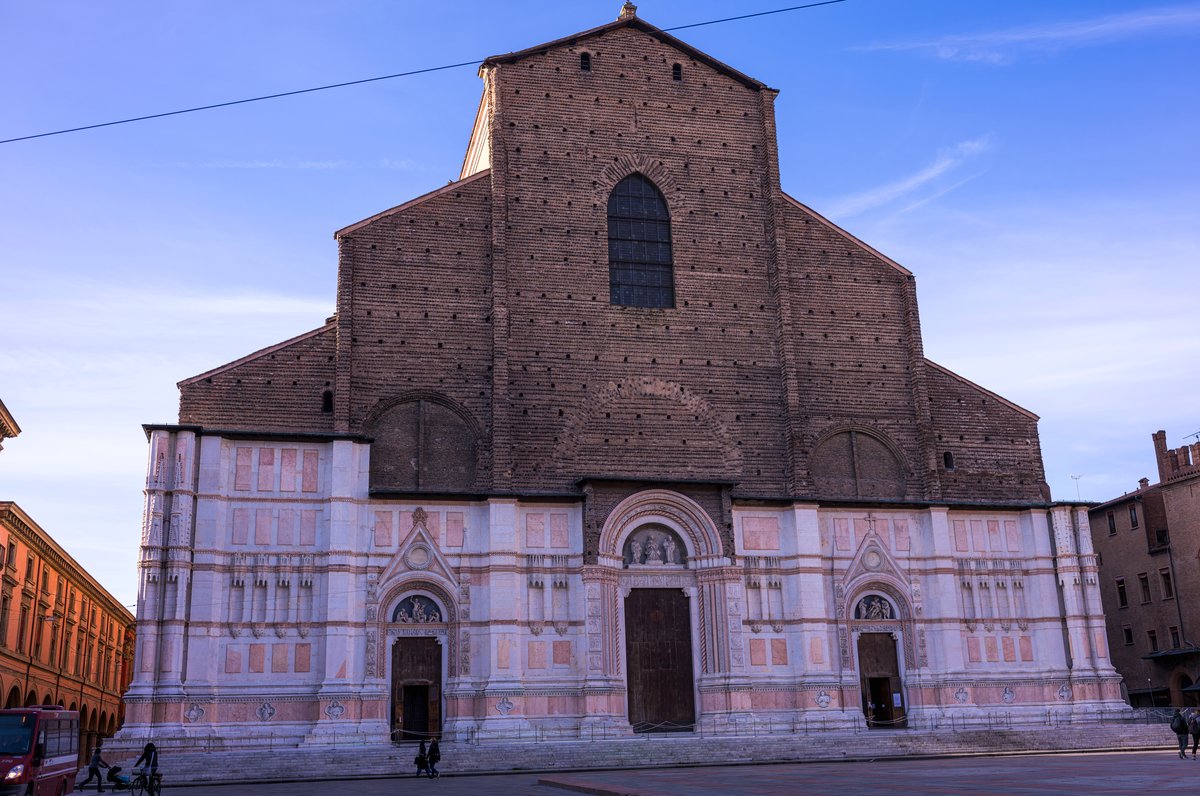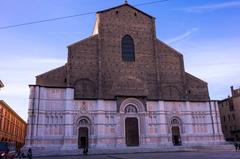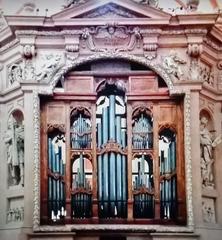
San Petronio Basilica: Visiting Hours, Tickets, and Historical Significance in Bologna
Date: 14/06/2025
Introduction
The Basilica di San Petronio is a monumental symbol of Bologna’s civic pride, artistic innovation, and religious devotion. Dominating Piazza Maggiore, this Gothic masterpiece was dedicated to Saint Petronius, Bologna’s 5th-century patron bishop. Ambitiously conceived in 1390, the basilica was intended to surpass even St. Peter’s Basilica in Rome, reflecting the city’s aspirations and autonomy. Today, it stands as one of the world’s largest brick churches, housing remarkable works of art and scientific ingenuity, notably the meridian line by Giovanni Domenico Cassini (travelsetu.com; basilicadisanpetronio.org).
This guide offers detailed information on San Petronio’s history, architecture, visiting hours, ticketing, accessibility, and nearby attractions, ensuring a memorable and meaningful visit to one of Bologna’s most treasured historical sites.
Table of Contents
- Origins and Dedication
- Construction Timeline and Ambitions
- Architectural Features and Artistic Heritage
- The Meridian Line: Scientific Significance
- Civic and Religious Role
- Visiting Hours and Tickets
- Accessibility
- Travel Tips and Getting There
- Nearby Attractions
- Special Events and Seasonal Highlights
- Preservation and Modern Adaptations
- Technology and Virtual Experiences
- FAQ
- Conclusion
- Sources
Origins and Dedication
The genesis of San Petronio Basilica is intertwined with Bologna’s quest for civic and religious identity. Dedicated to Saint Petronius, who shaped the city’s early Christian community, the basilica’s construction was a project of the people, not the papacy, symbolizing both spiritual reverence and municipal independence (travelsetu.com).
Construction Timeline and Ambitions
Construction commenced in 1390 during a period of intense rivalry among Italian city-states. The basilica was designed to be larger than St. Peter’s in Rome, a statement of Bologna’s wealth and autonomy. However, papal intervention and shifting political priorities led to a reduction in scale. Despite this, the basilica remains one of the largest churches in the world, measuring approximately 132 meters in length, 66 meters in width, and rising 47 meters at the nave (travelsetu.com; amusingplanet.com).
Architectural Features and Artistic Heritage
San Petronio is a paragon of Italian Gothic architecture, featuring an imposing, unfinished brick façade—marble below, brick above—that reflects its turbulent history. The basilica’s interior is renowned for its vast nave and 22 side chapels, each sponsored by influential Bolognese families and guilds. These chapels contain exceptional works from artists such as Jacopo della Quercia, Properzia de’ Rossi, Amico Aspertini, and Giovanni da Modena (basilicadisanpetronio.org; hotelcosmopolitanbologna.com).
Porta Magna and Sculptural Program
The main entrance, the Porta Magna, is adorned with Jacopo della Quercia’s expressive biblical reliefs, while the side doors feature works by Alfonso Lombardi and Amico Aspertini. The fusion of Gothic and Renaissance elements is evident throughout, with elaborate altarpieces, stained glass, and detailed sculpture.
The Bolognini Chapel
A must-see, the Bolognini Chapel is famed for its vivid frescoes of the Last Judgement, Heaven, Hell, and the Three Kings’ stories. It uniquely includes a medieval depiction of the Prophet Mohammed, which has drawn historical interest and controversy (Cestee).
The Meridian Line: Scientific Significance
Installed in 1655 by astronomer Giovanni Domenico Cassini, the basilica’s 66.8-meter meridian line is one of the world’s most precise sundials, used for astronomical observations and calculating the date of Easter. This feature highlights Bologna’s legacy as a center of scientific inquiry during the Renaissance and Enlightenment (basilicadisanpetronio.org).
Civic and Religious Role
San Petronio has served as more than a church; it is a hub for both spiritual and civic life. Its Piazza Maggiore location makes it central to religious ceremonies, festivals, and important civic events, including papal visits and coronations. The basilica’s construction and continued use reflect the Bolognese community’s enduring commitment to both faith and public life (hotelcosmopolitanbologna.com).
Visiting Hours and Tickets
- Basilica: Daily, 8:30 a.m. – 1:30 p.m. and 3:00 p.m. – 6:30 p.m. (last entry 10 minutes before closing)
- Museum: Daily, 9:00 a.m. – 12:45 p.m. and 3:00 p.m. – 5:45 p.m.
- Bolognini Chapel: 9:00 a.m. – 12:45 p.m. (last entry 12:00 p.m.), 3:00 p.m. – 5:45 p.m. (last entry 5:00 p.m.) (official info and hours)
Ticket Information
- Main Basilica: Free entry
- Special Chapels (Bolognini, San Sebastiano, San Vincenzo Ferrer): €5 full price, €3 reduced, free for children under 10 and other qualifying categories (ticket info)
- Group Visits: Reservation required for groups of 15+, schools, and organized tours (group visits)
Accessibility
The basilica is wheelchair accessible, with a dedicated entrance and ramp on Via de’ Pignattari. Restrooms and assistance are available on request. It is advisable to contact the basilica ahead of your visit for special accommodations (basilicadisanpetronio.org).
Travel Tips and Getting There
Situated in Piazza Maggiore, San Petronio is easily reached on foot from anywhere in Bologna’s city center. Public transport routes A, C, 29, 11, and 27 stop nearby. For drivers, parking is available in surrounding garages, though limited in the historic center. Early morning and late afternoon visits offer a quieter experience.
Nearby Attractions
San Petronio’s central location makes it an ideal starting point for exploring Bologna’s renowned sites, including:
- Fountain of Neptune
- Palazzo d’Accursio
- The Two Towers
- Archiginnasio Library
Local cafes, restaurants, and shops abound, offering traditional Bolognese cuisine and souvenirs (Taste Bologna).
Special Events and Seasonal Highlights
Major events include the Feast of San Petronio (October 4), religious festivals, concerts, and art exhibitions. Check the basilica’s event calendar for up-to-date information.
Preservation and Modern Adaptations
Ongoing restoration efforts address the effects of time, pollution, and tourism. The basilica also offers educational programs, audio guides, and museum exhibits to enhance visitor engagement while preserving its historic fabric (travelsetu.com).
Technology and Virtual Experiences
San Petronio has embraced technology with virtual tours and augmented reality, allowing global audiences to experience its architecture and art remotely—an initiative that proved vital during recent global travel restrictions (travelsetu.com).
Frequently Asked Questions (FAQ)
Q: What are the Basilica di San Petronio visiting hours?
A: The basilica is open daily, 8:30 a.m. – 1:30 p.m. and 3:00 p.m. – 6:30 p.m. (last entry 10 minutes before closing). Always check the official website for updates.
Q: Is there an admission fee?
A: Entry to the main basilica is free. Special chapels require tickets (€5 full price, €3 reduced).
Q: Are guided tours available?
A: Yes, guided and group tours can be booked in advance via the official website.
Q: Is the basilica accessible for visitors with disabilities?
A: Yes, accessibility features and assistance are available.
Q: Can I take photographs inside?
A: Photography is permitted, but flash is prohibited in certain chapels to protect artworks.
Conclusion
The Basilica di San Petronio is more than a landmark—it is a living testament to Bologna’s history, culture, and spirit. Its monumental scale, unfinished yet striking façade, and richly adorned chapels invite visitors to experience the city’s layered past and vibrant present. Whether you are captivated by Gothic architecture, Renaissance art, or scientific marvels like Cassini’s meridian line, a visit to San Petronio is a journey into the heart of Bologna. For the most fulfilling experience, check visiting hours, secure tickets for special chapels, and explore nearby attractions. Enhance your visit with digital resources like the Audiala app, and consult the basilica’s official website for current information.
Sources and Further Reading
- Basilica di San Petronio in Bologna: Visitor’s Guide to History, Art, and Practical Information, 2023, TravelSetu (travelsetu.com)
- San Petronio Basilica in Bologna: Visiting Hours, Tickets, and Cultural Significance, 2023, Basilica di San Petronio Official Site and Amusing Planet (basilicadisanpetronio.org; amusingplanet.com)
- San Petronio Basilica: Visiting Hours, Tickets, and Architectural Highlights of Bologna’s Iconic Historical Site, 2023, Basilica di San Petronio Official Website and Hotel Cosmopolitan Bologna (basilicadisanpetronio.org; hotelcosmopolitanbologna.com)
- Basilica di San Petronio Visiting Hours, Tickets, and Guide to Bologna’s Historic Landmark, 2024, Official Basilica di San Petronio Website (basilicadisanpetronio.org)
For guided audio tours and digital resources, download the Audiala app. For official updates and booking, always refer to the Basilica di San Petronio website and the Bologna Tourism Board.

































